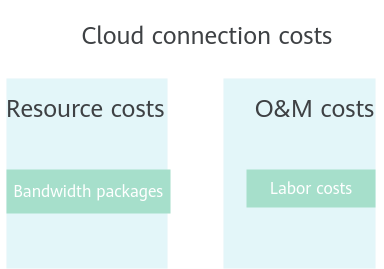Cost Management
As you migrate more of your services to the cloud, managing cloud costs becomes more important. For example, you may be more concerned with cost management when using Cloud Connect. This topic describes how you can manage costs in terms of cost composition, allocation, analysis, and optimization. Optimizing costs can help you maximize return on investment.
Cost Composition
A cloud connection costs consist of two parts:
- Resource costs: cost of resources and resource packages, depending on the billing items of cloud connections. For details, see Billing Items.
- O&M costs: labor costs incurred during the use of cloud connections.

Huawei Cloud Cost Center helps you manage resource costs with ease. However, you need to identify, manage, and optimize O&M costs by yourself.
Cost Allocation
A good cost accountability system is a prerequisite for cost management. It ensures that departments, business teams, and owners are accountable for their respective cloud costs. An enterprise can allocate cloud costs to different teams or projects so that you can have a clear picture of their respective costs.
Huawei Cloud Cost Center provides various tools for you to group costs in different ways. You can experiment with these tools and find a way that works best for you.
- By linked account
The enterprise master account can manage costs by grouping the costs of its member accounts by linked account. For details, see Viewing Costs by Linked Account.
- By enterprise project
Before allocating costs, enable Enterprise Project Management Service (EPS) and plan your enterprise projects based on your organizational structure or service needs. When purchasing cloud resources, select an enterprise project so that the costs of the resources will be allocated to the selected enterprise project. For details, see Viewing Costs by Enterprise Project.
Figure 2 Selecting an enterprise project for a cloud connection bandwidth package
- By cost tag
You can use tags to sort your Huawei Cloud resources in a variety of different ways, for example, by purpose, owner, or environment. The following is the process of managing costs by predefined tags (recommended).
 Figure 3 Adding tags to a cloud connection bandwidth package
Figure 3 Adding tags to a cloud connection bandwidth package
For details, see Viewing Costs by Cost Tag.
- By cost category
You can use cost categories provided by Cost Center to split shared costs. Shared costs are the costs of resources (compute, network, storage, or resource packages) shared across departments or the costs that cannot be directly split by cost tag or enterprise project. These costs are not directly attributable to a singular owner, and they cannot be categorized into a singular cost type. In this case, you can define cost splitting rules to fairly allocate these costs among teams or business units. For details, see Viewing Costs by Cost Category.
Cost Analysis
To precisely control and optimize your costs, you need a clear understanding of what parts of your enterprise incurred different costs. Cost Center visualizes your original costs and amortized costs using various dimensions and display filters for cost analysis so that you can analyze the trends and drivers of your service usage and costs from a variety of perspectives or within different defined scopes.
You can also use cost anomaly detection provided by Cost Center to detect unexpected expenses in a timely manner. In this way, costs can be monitored, analyzed, and traced.
For details, see Performing Cost Analysis to Explore Costs and Usage and Enabling Cost Anomaly Detection to Identify Anomalies.
Cost Optimization
- Cost control
You can create different types of budgets on the Budgets page of Cost Center to track your costs against the budgeted amount you specified. If the budget thresholds you defined are reached, Cost Center will send alerts to the recipients you configured. You can also create budget reports and specify recipients to receive budget alerts if any at a frequency you configured.
Suppose you want to create a monthly budget of $2,000 USD for using Cloud Connect and expect to receive an alert if the forecasted amount exceeds 80% of the budgeted amount. You can refer to the following budget information.
Figure 4 Basic budget information Figure 5 Defining the budget scope
Figure 5 Defining the budget scope Figure 6 Setting a budget alert
Figure 6 Setting a budget alert
For details, see Creating Forecasts and Budgets to Track Costs and Usage.
- Resource rightsizing
Cloud Eye helps you monitor resource usage, identify idle resources, and find opportunities to save costs. You can also identify resources with high costs based on Cost Analysis, and then take optimization measures accordingly.
- Monitor resource usage and evaluate whether the current configuration is more than you need. For example, you can monitor the bandwidth usage.
- Detect idle resources to avoid waste. For example, there may be global private bandwidths that are not bound to any instance.
- O&M automation
Huawei Cloud also provides various O&M products to help you improve O&M efficiency and reduce labor costs. The following are examples of such products:
- Auto Scaling: You can automatically and continuously maintain pay-per-use bandwidths. Use this service when there is a clear distinction between peak and off-peak workloads.
- Auto Launch Group: In just a few clicks, you can deploy instance clusters that use different billing modes, are distributed across AZs, and have different instance specifications. Use this method when stable computing power needs to be quickly delivered and spot instances need to be used to reduce costs.
- Resource Formation Service: Resource stacks with multiple cloud resources and dependencies can be deployed and maintained with just a few clicks. Use this service to deliver the entire system or clone an environment.
Feedback
Was this page helpful?
Provide feedbackThank you very much for your feedback. We will continue working to improve the documentation.See the reply and handling status in My Cloud VOC.
For any further questions, feel free to contact us through the chatbot.
Chatbot





